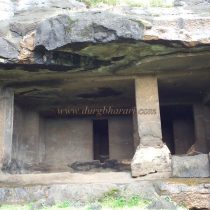KUDA
TYPE : BUDDHIST LENI
DISTRICT : RAIGAD
Kuda village is located at a distance of 24 km from Roha station of Konkan Railway. It is most convenient to visit the caves in Kuda by taking a rented passenger vehicle or own vehicle. Maharashtra State Transport Board buses run daily to Murud, which is about 24 km from Kuda. The caves of Kuda, located near Murud-Janjira, attract tourists due to the natural beauty of the surroundings and ancient history scholars due to the unique architectural style. Kuda is a quiet village in Raigad district, 130 km from Mumbai and 21 km southeast of Mangaon on the Mumbai-Goa highway. There is a group of 26 carved caves in a hill near the beach and the picturesque view of the Arabian Sea from here adds to the beauty of the caves. Kuda is included among a select few Buddhist caves built in the 3rd century CE. The first record of these caves dates back to 1848. But even after that, the cave was not very famous for many years.
...
The reason for this is that to go there one has to cross the creek at Rajapuri. Now the means of communication are available and since Mumbai to Kuda bus has started, it has become more convenient to visit this place. These caves are very close to Mandad. Mandad is the port of Mandagora mentioned by Roman writers. Excavations at this place have found stones and bricks dating back to about 2000 years ago. It is believed to be the main center of the Mandava dynasty of the Mahabojas of the Satavahana Empire. The caves at Kuda are carved in two phases, Caves No. 1 to 15 are in the lower level and Caves No. 16 to 26 are in the upper level. All these caves belong to the Hinayana sect of Buddhism, in which stupa worship was prevalent. Buddha images were installed in the sixth century AD. Out of the 26 caves of Kuda, there are 4 chaityagruhas. The inscriptions on the walls and pillars here give information about the donors. Cave No. 1 here shows a further development, in which we see a temple consisting of pavilions, and sanctum sanctorum with stupas. A new feature of the architectural style found here is the carved space adjacent to the sanctum sanctorum with stupa. Spaces appear hollowed out to fit against the walls. An inscription on the inside of the veranda records the donation by Sivabhuti, son of Sulsadat and Udaradat. The donor of the said cave, Sivabhuti and his wife Nanda, were both employed as scribes by Mahabojas Mandava Khandapalit, son of Sadgeri Vijay. Interestingly, this article has been engraved by the donor himself. That is why, the letters in the article should be drawn with an effort to be attractive and elegant. Cave no. 6 is the last to be carved here, the largest and the best Cave, and it has been duly carried to completion without leaving the work half-finished. Looking at these sculptures at Kuda, it can be inferred that they must be of the Satavahana period. These sculptures are slightly rougher than those at Karle, but are straighter than those at Kanheri (Cave No. 3). Apart from four caves, Kuda has one pavilion and twenty-one viharas. The viharas of Kuda are completely different from the ancient viharas with a square hall or open space in the center and rooms on all four sides. The decline in trade with the Western world, the resulting political instability, and the economic downturn all resulted in a lack of patronage for such cave carving. This led to the construction of small caves with one or two rooms with a veranda at the front and a room for meditation in the back. Such caves had no decoration carvings. It can be said for certain that the Kuda Caves are silent witnesses of the glittering glory of the Satavahana period. Tourists must visit the caves in Kuda which offer a panoramic view of the Arabian Sea.
© Suresh Nimbalkar





















